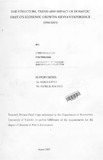| dc.description.abstract | This study seeks to examine the structure, magnitude, level, and determinants of
public domestic debt in Kenya for the period 1990-2001. It further examines the trend
and impact of domestic debt directly on the economic growth, and indirectly on
capital formation and private cum public sector investment.
The study employs use of time series data for the period 1990 to 2001. The statistics
show that a major proportion of Kenya' s outstanding stock of public domestic debt of
Kshs 222.0 billion (or 36.6% of the total stock of debt) as at the end of December
2001 is short-term. Thus it is in the form of Treasury bills whose tenor is below one
year. This makes repayment very expensive and detriment to the economy.
History of domestic debt problem in Kenya can be traced back to 199211993. Thus
domestic debt crisis is a 1990s phenomenon. The increment in public domestic debt
over the period under study can be attributed to a number of factors. These include;
diminishing inflow of external grants and concessional loans, use of government
securities to mop up excess money supply following the excessive liquidity released in
the economy in 1992 and 1993, frequent net repayments of external debt, budgetary
support to inefficient parastatals, loose fiscal policy, and the need to sterilize large
short-term capital inflows attracted by the high interest rates.
Theoretical literature shows that prudent borrowing to finance a budget deficit is not a
problem. However, servicing of huge accumulated domestic debt channels resources
away from essential government operations, especially development projects. For
instance, interest cost on debt raises Government recurrent expenditure (currently
stands at 12% of the total government expenditure), which worsens the budget deficit. Although the current domestic debt servicing 'crowds-out' private sector investment,
the effect is not significant as at now. But the trend at which it is accumulating is a
major issue of concern. In the current government recurrent expenditure estimates,
about 38% of the total estimates will be spend on debt servicing. This research
proposes various policy recommendations to manage Kenya's domestic debt before it
reaches detrimental levels. | en |

